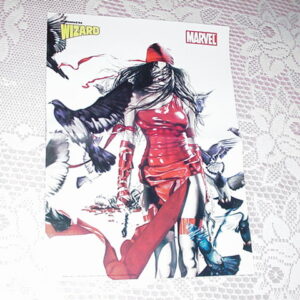Spider-Man Poster #136 Chameleon (Dmitri Smerdyakov) by Creator, Steve Ditko
$34.99
Description
Chameleon first appears in The Amazing Spider-Man #1 (March 1963), and was created by writer Stan Lee and artist Steve Ditko; the Chameleon is the first member of Spider-Man’s rogues’ gallery, based on issue publication date, excluding the burglar who murdered Ben Parker (Supercharger was the first Spider-Man supervillain chronologically).
The Chameleon was born a Soviet citizen named Dmitri Smerdyakov. In his youth, he was a servant and half-brother to Kraven the Hunter, Sergei Kravinoff, and eventually became a minor associate to one Gustav Fiers.
Originally, the Chameleon had no superhuman powers and simply used makeup and elaborate costuming to impersonate his targets. In order to do this, he implemented a device in a belt buckle that emitted a gas that helped him mold his features. Later, the Chameleon obtained a microcomputer from Spencer Smythe for his belt buckle that could be programmed with the facial features of hundreds of people. The belt buckle also contains a video receiver that enables the computer to analyze the appearance of anyone the Chameleon encounters so that it can duplicate his/her features using electrical impulses. The computer utilizes holographic technology that allowed him to change his appearance at the push of a button. His electronic devices allowed him to appear as two different people to two separate observers simultaneously. The Chameleon’s costume consists of “memory material” that can be altered by electrical impulses from his belt so as to resemble the clothing of the person he is impersonating.
Later, the Chameleon’s powers are made innate: his epidermis and skin pigmentation have been surgically and mutagenically altered by a serum so that he can take on the appearance of any person at will. He also wears fabric made of memory material that responds to nerve impulses and can appear to be what ever costume he wishes to be.
Stephen J. “Steve” Ditko (born November 2, 1927) is an American comic book artist and writer best known as the artist and co-creator, with Stan Lee, of the Marvel Comics heroes Spider-Man and Doctor Strange.
Ditko studied under Batman artist Jerry Robinson at the Cartoonist and Illustrators School in New York City. He began his professional career in 1953, working in the studio of Joe Simon and Jack Kirby, beginning as an inker and coming under the influence of artist Mort Meskin. During this time, he then began his long association with Charlton Comics, where he did work in the genres of science fiction, horror, and mystery. He also co-created the superhero Captain Atom in 1960.
During the 1950s, Ditko also drew for Atlas Comics, a forerunner of Marvel Comics. He went on to contribute much significant work to Marvel, including co-creating Spider-Man, who would become the company’s flagship character. Additionally, he co-created the supernatural hero Doctor Strange and made important contributions to the Hulk and Iron Man. In 1966, after being the exclusive artist on The Amazing Spider-Man and the “Doctor Strange” feature in Strange Tales, Ditko left Marvel for reasons never specified.
Ditko continued to work for Charlton and also DC Comics, making major contributions, including a revamp of the long-running character Blue Beetle, and creating or co-creating the Question, the Creeper, Shade, the Changing Man, and Hawk and Dove. Ditko also began contributing to small independent publishers, where he created Mr. A, a hero reflecting the influence of Ayn Rand’s philosophy of Objectivism. Since the 1960s, Ditko has declined most interviews, stating that it is his work he offers readers, and not his personality.
Lee and Ditko’s collaboration on the series saw the creation of many of the character’s best known antagonists including Doctor Octopus in issue #3 (July 1963); the Sandman in #4 (Sept. 1963); the Lizard in #6 (Nov. 1963); Electro in #9 (March 1964); and the Green Goblin in #14 (July 1964). Ditko eventually demanded credit for the plotting he was contributing under the Marvel Method. Lee concurred, and starting with #25 (June 1965), Ditko received plot credit for the stories.
Ditko was inducted into the comics industry’s Jack Kirby Hall of Fame in 1990, and into the Will Eisner Award Hall of Fame in 1994.
Near mint condition.
Related products
-


Elektra Poster # 2 by Rodolfo Migliari Daredevil Thunderbolts
$29.99 Add to cart -


Daredevil vs Elektra Poster Ultimate Salvador Larroca
$29.99 Add to cart -


Ultimate Spider-Man Thing Wolverine Poster David Finch X-Men Fantastic Four
$29.99 Add to cart -


X-Men Poster #36 Mystique Joseph Michael Linsner Dawn
$34.99 Add to cart


